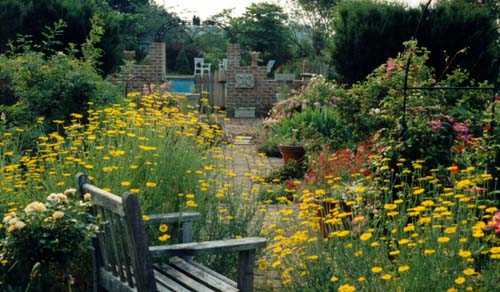Perennials
are plants that come back year
after year, bringing joy to all
who plant and watch them grow. |
Everywhere you turn there is someone
touting the joys of perennial gardens
on televisions, in print or over your
backyard fence. Just what the heck is
all this talk about and should you have
a perennial garden in your yard? Simply
stated the answer is Yes!
Investing in perennials is an investment
in tomorrow. All perennials will spread
as they grow from year to year. They
will increase in size and in the number
of blooms produced each season. In a
few short years, you will be rewarded
with an array of plants ranging from
one end of the colour spectrum to the
other.

Selecting
Perennials
There are literally thousands of different
types of plants that fall into the perennial
category so the choices are endless.
They come in such a variety of shape,
size, color and texture that one can
create many different looks for any
yard, be it a large estate or the tiniest
town plot.
Since there are so many choices when
looking at perennials it is important
to make a planting plan. Perennials
range in size from the tiny matt forming
'Blue Star Creeper" (about 1"
tall) to the gigantic, fall flowerinfg
Confederate Rose Hibiscus that reaches
up to 10' in height! It is good to know
the final height of a perennial plants
in order to place them appropriately
in your garden.
You should also get to know the bloom
period of each plant. Some perennials
will bloom for a month or so while others
will bloom all season as many annuals
do. Most people like to have a succession
of blooms from earliest spring to the
last fall frost so plant choices are
important. It's good to have a mix of
perennial plants in your garden in order
to achieve this prolonged blooming.
Another consideration is where are
you going to put these plants? Will
the bed be sunny or shady? Perennials,
just like annuals have their preferences
and this should be taken into account
when choosing your perennials.
The sun
loving perennials prefer a sunny
site that is well drained soil. There
are many outstanding shade
loving perennials that do well in
shade, growing beautifully where you
cannot get grass to grow. Also there
are other perennials that like damp
conditions, while other drought
tolerant perennials require very
little if any water.
Planning
Your Perennial Garden
When planning for the size of a perennial
garden it's a good rule of thumb to
make the beds 1' in width for every
4' of length, however there is not set
size or shape. So a garden that is 20'
in length might be at 5' deep. If you
can make it deeper all the better for
there will be more room for big, impressive
plants with masses of flowers and more
plants of differing heights and textures,
as well as differing bloom periods.
Now, choosing which perennials to use
in specific sites. There are a great
number of books
about perennials on the market,
each geared to different levels and
tastes, or you can simply use the free
information provided right here at Wilson
Bros Online! When choosing your perennials
try to achieve a balance between tall
and short, early bloomers and late,
differing colors and textures. Visit
the Perennial
Home Page to find listings of all
the various types of perennials that
perform well in the Atlanta metro area,
and other areas of the south.
Perhaps the most popular perennial
garden themes these days involve butterfly
perennials and hummingbird
perennials. Almost equally as popular
are perennials
for cut flowers.
Interest and use of perennial
herbs, whether alone or mixed in
the perennial garden, is steadily growing
in popularity as many people use them
for cullinary purposes as well as ornamental
value.
Sketch you garden out ona sheet of
paper after you've selected the species
an varieties you want to include.

Perennial
Listings by Category
Planting
Perennials
There are different methods for planting
perennials in the garden. Visit Instructions
For Planting A Perennial to find
the way we like to plant them. Some
folks say its best to till up the entire
garden area, however, we've found that
this can bring lots of buried weeds
seeds to the surface and also promotes
invasiveness of certain types of perennials,
or weeds that may sprout. Of course
you can till the entire area if you
like. We prefer not to disturb all the
soil in the garden. Instead we do the
following: